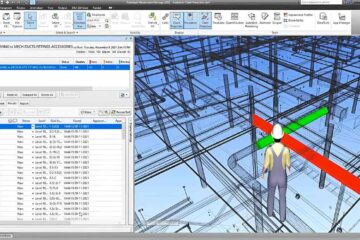Introduction to BIM for Architects
In today’s rapidly evolving architectural landscape, the integration of technology has become paramount. One such technology, Building Information Modeling (BIM), has revolutionized the way architects approach design and construction projects. With the aid of Autodesk’s innovative software solutions, architects are effectively leveraging the power of BIM to streamline their workflows and enhance collaboration with stakeholders.

Understanding Building Information Modeling (BIM) – Recognizing its impact on the construction industry.
Building Information Modeling (BIM) is a digital representation of the physical and functional characteristics of a building. It allows architects to create detailed 3D models that encompass both the visual and data aspects of a structure throughout its lifecycle, demonstrating how BIM allows for comprehensive project visualization and management.
Role of BIM in Architectural Design and Construction – BIM allows for better planning and execution throughout the design phase.
BIM plays a crucial role in the architectural design, computer-aided design (CADD) and construction process by enabling architects to make informed design decisions based on accurate and up-to-date information, which is essential during the design phase. It helps in identifying and resolving design issues early on, leading to more efficient project delivery, demonstrating how BIM helps in the process.
Benefits of BIM for Architects
BIM offers a myriad of benefits for architects, including streamlined workflows, improved collaboration among stakeholders, and enhanced accuracy in design documentation, making it a significant Building Information Modelling (BIM) benefit. By using BIM tools such as Autodesk’s Revit, architects can create intricate 3D models, optimize the design process, and facilitate a more collaborative working environment.
Utilizing Building Information Modeling (BIM) Software in Architecture
Building Information Modeling (BIM) software has revolutionized the architecture industry by enhancing the way architects design and construct buildings. When it comes to architects exploring various BIM software options, they have a plethora of tools at their disposal, ranging from Autodesk’s Revit to other specialized solutions tailored to meet the specific needs of architectural firms. Each software brings its unique features and functionalities, catering to different aspects of the design and construction process.
Exploring BIM Software Options for Architects
Architects have a wide array of BIM software options to choose from, each offering unique tools and capabilities to support their design and construction projects. Autodesk’s Revit, known for its powerful 3D modeling capabilities, is a popular choice among architects as it enables them to create detailed architectural models and streamline their workflows efficiently. Other software like AutoCAD Architecture and ArchiCAD also provide specialized tools that cater to specific aspects of the architectural design process.
Benefits of Implementing BIM Software in Architectural Projects
The implementation of BIM software in architectural projects brings numerous benefits to architects and the entire project team. BIM enhances collaboration among stakeholders by providing a centralized platform for sharing and accessing project data in real-time. It improves the accuracy of design documentation, reduces errors during construction, and facilitates better coordination among different disciplines involved in the project.
How BIM Enhances AEC (Architecture, Engineering, and Construction) Processes
BIM technology plays a pivotal role in enhancing Architecture, Engineering, and Construction (AEC) processes by offering a collaborative and data-driven approach to project delivery. By utilizing BIM, architects can effectively communicate design intent, analyze building performance, and simulate construction processes to identify potential conflicts before they occur. This integration of BIM in AEC processes streamlines project workflows, improves decision-making, and ultimately leads to the successful delivery of high-quality architectural projects.
Maximizing Architectural Design with BIM
Architects today are embracing innovative approaches to architectural design by leveraging the power of Building Information Modeling (BIM). This technology not only allows architects to create intricate 3D models but also revolutionizes the design process by enabling architects to explore unique and creative design concepts. With the aid of BIM software like Autodesk’s Revit, architects can bring their architectural visions to life with enhanced accuracy and efficiency. BIM opens up new possibilities for architects to push the boundaries of traditional design and create structures that are both functional and visually stunning.
Innovative Architectural Design Approaches with BIM
One of the key advantages of using BIM in architectural design is the ability to adopt innovative approaches that go beyond conventional design norms. Architects can experiment with complex forms, sustainable design strategies, and parametric modeling techniques to create buildings that are not only aesthetically pleasing but also environmentally friendly and efficient. BIM empowers architects to explore new design horizons and push the limits of creativity, resulting in buildings that resonate with the evolving needs of society.
Benefits of BIM for Realizing Unique Architectural Concepts
Architects leveraging BIM software gain a competitive edge in realizing unique architectural concepts that stand out in the industry. BIM tools facilitate the visualization of design ideas, allowing architects to communicate their concepts effectively to clients and stakeholders. By simulating the building’s performance and conducting virtual walkthroughs, architects can refine their designs and ensure that the final structure meets the intended design intent. BIM not only enables the realization of visionary architectural concepts but also enhances the overall quality and efficiency of the design process.
Enhancing Collaboration through BIM in Architectural Projects
BIM serves as a catalyst for enhanced collaboration among stakeholders involved in architectural projects. By centralizing project data and providing a shared platform for communication, BIM fosters greater coordination among architects, engineers, contractors, and clients. Through real-time data sharing and collaborative workflows, BIM streamlines decision-making processes, reduces errors, and ensures that all project stakeholders are aligned towards the common goal of delivering a successful architectural project. The collaborative nature of BIM transforms traditional project dynamics and paves the way for seamless teamwork and integrated project delivery.
Frequently Asked Questions (FAQs)
What are the benefits of BIM for architects?
BIM (Building Information Modeling) enables architects to create detailed designs, make better design decisions earlier in the process, and improve overall design quality. It also helps architects make informed decisions throughout the design process and supports construction documentation.
How does BIM benefit architects in their work?
BIM enables architects to use 3D models for conceptual design, collaborate with clients and stakeholders, streamline communication within the team, and avoid clashes or errors in the design process.
What software for architecture can architects use to maximize the benefits of BIM?
Architects can use Autodesk software to leverage the full potential of BIM in their projects. Autodesk provides tools for CAD, 2D drafting, BIM design, MEP (mechanical, electrical, plumbing) systems, and design review.
How does BIM enhance the work of architects?
BIM makes the work of architects more efficient by creating a digital representation of the building project. It enables collaboration, visualization, and analysis that leads to better decision-making and improved communication with clients.
How can architects maximize the benefits of BIM workflows?
Architects can maximize the benefits of BIM workflows by using the technology throughout the entire design process, from conceptualization to construction documentation. This allows for more accurate project estimates, clash detection, and improved coordination among disciplines.
How does BIM enable architects to create detailed designs?
BIM enables architects to create detailed designs by providing a platform to model and visualize every aspect of the building project in a 3D environment. This helps architects to accurately represent their design intent and make necessary modifications easily.
What are the key advantages of using BIM for architects and clients?
The key advantages of using BIM for architects and clients include improved design visualization, enhanced collaboration, reduced errors during construction, better cost estimation, and the ability to make design changes more efficiently throughout the project lifecycle.



